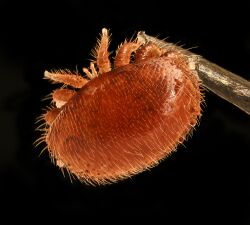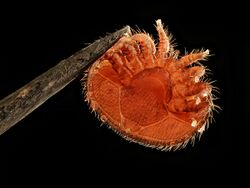Biology:Varroa
| Varroa | |
|---|---|

| |

| |
| Varroa destructor in dorsal (top) and ventral (lower) views | |
| Scientific classification | |
| Domain: | Eukaryota |
| Kingdom: | Animalia |
| Phylum: | Arthropoda |
| Subphylum: | Chelicerata |
| Class: | Arachnida |
| Order: | Mesostigmata |
| Superfamily: | Dermanyssoidea |
| Family: | Varroidae Delfinado & Baker, 1974[3] |
| Genus: | Varroa Oudemans, 1904[1][2] |
| Species | |
|
Varroa destructor | |
Varroa is a genus of parasitic mesostigmatan mites associated with honey bees, placed in its own family, Varroidae.[4] The genus was named for Marcus Terentius Varro, a Roman scholar and beekeeper. The condition of a honeybee colony being infested with Varroa mites is called varroosis (also, incorrectly, varroatosis).
Varroa mites, specifically the species Varroa destructor, are recognised as the biggest pest to honeybees worldwide due to their ability to transmit diseases such as deformed wing virus (or DWV) to larval or pupating bees, resulting in death or severe deformity of the pupae.
History and behavior
Varroa mites feed off the fat body tissue of adult, pupal, and larval honey bees,[5] and may carry viruses that are particularly damaging to the bees (e.g., deformed wings, and IAPV), and accordingly they have been implicated in colony collapse disorder. Research has indicated that alone, neither Varroa mites nor deformed wing virus are particularly deadly, yet together they can pose an incredible risk to colonies.[6][7]
Varroa mites were first discovered in Java about 1904,[8] but are now present in all honey bee populations except the Isle of Man and Isle of Colonsay. Because of the lack of varroa in Isle of Man, on February 16, 2015, the EU made a decision that allowed the Isle of Man to block the importation of all bee-related supplies.[9]
They were discovered in the United States in 1987, in New Zealand in 2000,[10] and in the United Kingdom in 1992.[citation needed]
Australia was free of the mites until a routine inspection at the Port of Newcastle on 22 June 2022 detected an infestation.[11] Eradication is unlikely because no other introduction elsewhere in the world has been eradicated.[12] On 9 November 2023, ABC News reported that researchers have predicted the extinction of feral bees in Australia within three years because of the spreading Varroa mite infestation.[13]
Bee-breeding efforts to develop resistance against Varroa are ongoing. The USDA has developed a line of bees which uses Varroa-sensitive hygiene to remove reproductive mites. This line is now being distributed to beekeepers to be used as part of their integrated pest management programs.
Varroosis
The infestation and subsequent parasitic disease caused by mites in the genus Varroais called varroosis.[14] Sometimes, the incorrect names varroatosis or varroasis are used. A parasitic disease name must be formed from the taxonomic name of the parasite and the suffix -osis[15] as provided in the Standardised Nomenclature by the World Association for the Advancement of Veterinary Parasitology.[16] For example, the World Organisation for Animal Health (OIE) uses the name varroosis in the OIE Terrestrial Manual.[17]
Species
The genus Varroa contains these species:[4]
- Varroa destructor Anderson & Trueman, 2000[8] – a virulent parasite that infests its natural host, Apis cerana (Asian honey bees), on mainland Asia and also Apis mellifera (western honey bee) worldwide.
- Varroa jacobsoni Oudemans, 1904[1][2] – a relatively benign parasite of Apis cerana.
- Varroa rindereri de Guzman & Delfinado-Baker, 1996[18][19]
- Varroa underwoodi Delfinado-Baker and Aggarwal, 1987[18][19]
Resistance
Some honey bees strains have been bred to be resistant to Varroa,[20][21] through Varroa sensitive hygiene (VSH) behavior, enabling them to detect reproducing varroa mites and diseased pupae within capped cells, which are then uncapped and the pupae removed.
References
- ↑ 1.0 1.1 Oudemans, A. C. (1904). "On a new genus and species of parasitic Acari". Notes from the Leyden Museum 24 (4): 216–222. https://www.biodiversitylibrary.org/page/9644749.
- ↑ 2.0 2.1 Oudemans, A. C. (1904). "Acarologische Aanteekeningen XII". Entomologische Berichten 1 (18): 160–164. https://www.biodiversitylibrary.org/page/8982540.
- ↑ Delfinado, M. D.; Baker, E. W. (1974). "Varroidae, A new family of mites on honey bees (Mesostigmata: Acarina)". Journal of the Washington Academy of Sciences 64 (1): 4–10. https://www.biodiversitylibrary.org/page/39873197.
- ↑ 4.0 4.1 Joel Hallan. "Varroidae Delfinado & Baker, 1974". Texas A&M University. http://insects.tamu.edu/research/collection/hallan/Acari/Family/Varroidae.txt.
- ↑ Ramsey, Samuel D.; Ochoa, Ronald; Bauchan, Gary; Gulbronson, Connor; Mowery, Joseph D.; Cohen, Allen; Lim, David; Joklik, Judith et al. (2019-01-29). "Varroa destructor feeds primarily on honey bee fat body tissue and not hemolymph" (in en). Proceedings of the National Academy of Sciences 116 (5): 1792–1801. doi:10.1073/pnas.1818371116. ISSN 0027-8424. PMID 30647116.
- ↑ "Mites, Viruses Sicken Bee Hives - Colony Collapse Disorder - Hawaiian Honeybee Infection". LiveScience.com. 7 June 2012. http://www.livescience.com/20815-honeybee-collapse-mite-virus.html.
- ↑ "Bees Wiped Out by Cascade of Deadly Events". LiveScience.com. 17 May 2005. http://www.livescience.com/271-bees-wiped-cascade-deadly-events.html.
- ↑ 8.0 8.1 D. L. Anderson & J. W. H. Trueman (2000). "Varroa jacobsoni (Acari: Varroidae) is more than one species". Experimental and Applied Acarology 24 (3): 165–189. doi:10.1023/A:1006456720416. PMID 11108385.
- ↑ "Isle of Man Government - Bees". https://www.gov.im/categories/business-and-industries/agriculture/bees/.
- ↑ Zhi-Qian Zhang (2000). "Notes on Varroa destructor (Acari: Varroidae) parasitic on honeybees in New Zealand". Systematic & Applied Acarology. Special Publications 5: 9–14. http://www.nhm.ac.uk/hosted-sites/acarology/saas/saasp/pdf10/saasp05b.pdf.
- ↑ "New Varroa mite detection linked to Newcastle". 2022-07-04. http://newcastleweekly.com.au/new-varroa-mite-detection-linked-to-newcastle/.
- ↑ "Here’s what you need to know about the Varroa mite". 2022-07-04. http://www.anu.edu.au/news/all-news/here%E2%80%99s-what-you-need-to-know-about-the-varroa-mite.
- ↑ "Researcher says feral bees face extinction as deadly mite spreads in swarms" (in en-AU). ABC News. 2023-11-08. https://www.abc.net.au/news/rural/2023-11-09/deadly-parasite-varroa-mite-behind-predicted-feral-bee-die-off/102905408.
- ↑ "Varroosis of honey bees (infestation of honey bees with Varroa spp.)". OIE Terrestrial Health Manual. World Organisation for Animal Health. 2021. https://www.woah.org/fileadmin/Home/fr/Health_standards/tahm/3.02.07_VARROOSIS.pdf.
- ↑ Kassai, Tibor (June 2006). "Nomenclature for parasitic diseases: cohabitation with inconsistency for how long and why?". Veterinary Parasitology 138 (3–4): 169–178. doi:10.1016/j.vetpar.2006.02.019. PMID 16569483.
- ↑ "Standardised Nomenclature of Animal Parasitic Diseases". http://www.waavp.org/node/43.
- ↑ "Varroosis in honey bees". http://www.oie.int/fileadmin/Home/eng/Health_standards/tahm/2.02.07_VARROOSIS.pdf.
- ↑ 18.0 18.1 de Guzman, L. I.; Delfinado-Baker, M. (1996). "A new species of Varroa (Acari: Varroidae) associated with Apis koschevnikovi (Apidae: Hymenoptera) in Borneo". International Journal of Acarology 22 (1): 23–27. doi:10.1080/01647959608684077.
- ↑ 19.0 19.1 de Guzman, Lilia I.; Rinderer, Thomas E. (1999). "Identification and comparison of Varroa species infesting honey bees". Apidologie 30 (2-3): 85–95. doi:10.1051/apido:19990201.
- ↑ "Arista Bee Research - Foundation for breeding varroa resistant honey bees". aristabeeresearch.org. http://aristabeeresearch.org/.
- ↑ "USDA ARS Online Magazine Vol. 47, No. 8". usda.gov. http://agresearchmag.ars.usda.gov/1999/aug/bees.
External links
Wikidata ☰ Q1766457 entry
 |


